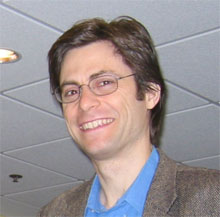
Tegmark
Max Tegmark (5 May 1967 - ) is a leading advocate of the view that the universe can be thought of as a mathematical structure, and that, further, all mathematical structures exist. He therefore rejects the abstract/concrete distinction; remarkable as the proposal is, it subtracts, rather than adds, to the ontological commitments of the Platonist , who is usually committed to the existence of physical concreta in addition to abstract objects. In this way he is able to account for what Wigner famously called ‘the unreasonable success of mathematics in the physical sciences’, as well as a number of other long-standing philosophical problems, including the nature of physical laws and the ontological status of possible worlds. His position bears some similarities to that of David Lewis.
Unsurprisingly, since the Many Worlds Interpretation (MWI) of quantum mechanics, first introduced by Hugh Everett III in 1957, adds nothing further to Tegmark’s ontology, he is also an advocate of MWI as the only interpretation of quantum theory that solves the problem of measurement without residue and without modification of the quantum mechanical formalism. Together with Anthony Aguirre, he has further developed the probabilistic interpretation of the MWI so as to apply uniformly to the interpretation of probability in settings in which qualitatively identical copies of macroscopic states of affairs are distributed throughout the universe (or multiverse), as seems inevitable given a sufficiently large universe -- extending if necessary, to infinite numbers of replicas in the case of an infinite universe.
Together with Daniel Eisenstein and Wayne Hu, he introduced the idea of using Baryon Acoustic Oscillations as a Standard Ruler. He has also developed a number of data analysis tools and applied them to Cosmic Microwave Background experiments such as COBE, QMAP, and WMAP, and to galaxy redshift surveys such as the Las Campanas Redshift Survey, the 2dF Survey and the Sloan Digital Sky Survey.
Tegmark was born in Sweden and studied at the Royal Institution of Technology in Stockholm. His obtained his doctorate from the University of California at Berkeley under the supervision of Joe Silk. He is now Professor of Cosmology at MIT, and Scientific Director of the Fundamental Questions in Physics Institute (FQXi).
Links
Max Tegmark: The Mathematical Universe (2007) >
Science Now: Do we live inside a mathematical equation? >
Multimedia
Oxford Miniseries: Cosmology and quantum foundations >
